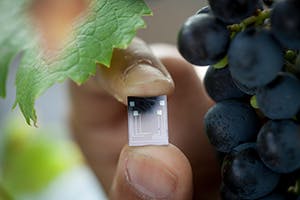With such an inexpensive and accurate sensors, growers can strategically space the chips in plants and soil for accurate measurements in agricultural fields across their entire operation.
Wine grape growers are a perfect example of a grower with a need for extremely specific moisture levels. Sophisticated vintners use precise irrigation to put regulated water stress on grapevines to create just the right grape composition for a premium cabernet or a chardonnay wine.
While growers can use the sensors to monitor water in soils for their crops, civil engineers can embed these chips in concrete to determine optimal moisture levels as the concrete cures.
“One of our goals is to try and develop something that is not only a great improvement, but also much cheaper for growers and others to use,” said Alan Lakso, professor of horticulture, who has been working on water sensing for 20 years.
The sensors make use of microfluidic technology – developed by Abraham Stroock, Cornell University associate professor of chemical and biomolecular engineering – that places a tiny cavity inside the chip. The cavity is filled with water, and then the chip may be inserted in a plant stem or in the soil where it, through a nanoporous membrane, exchanges moisture with its environment and maintains an equilibrium pressure that the chip measures.
Using chips embedded in plants or spaced across soil and linked wirelessly to computers growers may “control the precise moisture of blocks of land, based on target goals,” said Vinay Pagay, who helped develop the chip as a doctoral student in Lakso’s lab.
Ernest and Julio Gallo Winery and Welch’s juice company have already expressed interest in the sensors. And Cornell civil engineer Ken Hover has started working with Pagay and Lakso on testing and using the sensors in concrete.
The researchers seek to understand how values gathered from sensors inside a plant and in soils relate to plant growth and function, so that growers can translate sensor values and optimize management.


